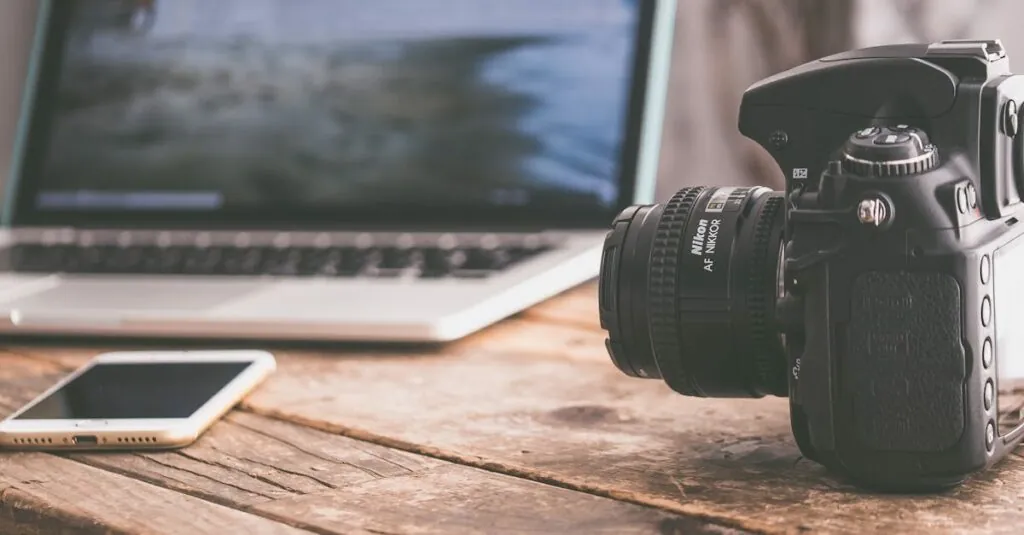Table of Contents
ToggleTransferring videos from an SD card to an iPhone might sound like a techy puzzle, but it’s easier than finding a needle in a haystack—if the needle was wearing a tiny party hat. Whether it’s those epic vacation clips or your cat’s latest shenanigans, getting your cherished moments onto your iPhone is a breeze with the right steps.
Imagine the joy of sharing those memories with friends and family without the hassle of complicated transfers. With a few simple tricks up your sleeve, you’ll be the tech-savvy hero of your own story. So grab your SD card and iPhone, and let’s dive into the fun world of video transferring—where every click brings you closer to reliving those unforgettable moments.
Understanding The Basics
Transferring videos from an SD card to an iPhone involves understanding some key concepts. Knowing what an SD card is and how it interacts with iPhones provides a solid foundation for this process.
What Is An SD Card?
An SD card, or Secure Digital card, is a small storage device used to store data. These cards come in various capacities, typically ranging from 2 GB to 1 TB. Users often rely on SD cards to save photos, videos, and other files from devices such as cameras and drones. Most devices support standard SD card formats, including SDHC and SDXC. They have become essential for anyone looking to manage large amounts of data conveniently.
How Does An SD Card Work With iPhones?
iPhones do not support direct SD card insertion. Instead, users utilize adapters or card readers to transfer files. By connecting an adapter to the iPhone’s Lightning port, one can access the SD card. This setup allows users to transfer videos seamlessly. It’s crucial to have compatible software on the iPhone for file management. Apple’s Photos app automatically detects media on the SD card, making the transfer process straightforward and intuitive.
Methods To Transfer Videos
Transferring videos from an SD card to an iPhone offers several straightforward methods. Each method caters to different user preferences and available tools.
Using The Apple Lightning To SD Card Camera Reader
This method involves using the Apple Lightning to SD Card Camera Reader, which connects directly to the iPhone’s Lightning port. Users insert the SD card into the reader, then plug the reader into their iPhone. The Photos app should launch automatically, displaying all videos stored on the SD card. Users can select specific videos for import. Once selected, tapping the “Import” button transfers videos directly to the iPhone’s library. This method ensures a seamless experience for users needing to access their cherished videos quickly.
Transfer Through A Computer
Transferring videos through a computer is another efficient option. Users connect the SD card to their computer, allowing access to its contents. They can copy the desired videos from the SD card to the computer’s hard drive. Afterward, connecting the iPhone to the computer with a USB cable enables syncing with iTunes or Finder. Users select the videos they want to transfer and initiate syncing. This process is beneficial for those who prefer managing files through a computer before transferring to their iPhone.
Step-By-Step Guide
Transferring videos from an SD card to an iPhone can be simple with a few straightforward methods. Two effective options include using the Lightning to SD Card Reader and a computer for transfers.
Using The Lightning To SD Card Reader
Using the Lightning to SD Card Reader offers a direct connection to the iPhone. First, connect the reader to the Lightning port on the device. Then, insert the SD card into the reader. The Photos app will open automatically, displaying the video files. After viewing the videos, select the ones to import. Tapping “Import” will start the process, allowing for quick access to cherished memories.
Using A Computer For Transfer
Transferring videos through a computer provides additional flexibility for file management. Begin by connecting the SD card to the computer via a card reader. Copy the desired videos to a local folder on the computer. Then, launch iTunes or Finder to sync these videos to the iPhone. Afterward, connect the iPhone to the computer. Navigate to the device in iTunes or Finder, select the videos folder, and click “Sync.” This method allows for meticulous organization before transferring files to the iPhone.
Troubleshooting Common Issues
Users often encounter challenges during the process of transferring videos from an SD card to an iPhone. Addressing these issues early can enhance the overall experience.
Connection Problems
Connection issues can arise when users plug in their SD card reader. If the iPhone doesn’t recognize the reader, it’s essential to check the compatibility of the reader with the device. Users should verify that the Lightning port is clean and free of debris. Restarting the iPhone can also resolve temporary glitches. Trying another SD card reader may help if problems persist. Moreover, ensuring the SD card is properly seated in the reader is crucial for successful connections.
Format Compatibility Issues
Format compatibility presents another potential hurdle. Users must confirm that video files saved on the SD card are supported by the iPhone. Common formats like MOV and MP4 are typically compatible. Those with incompatible formats will need to use conversion software to change the file types before transferring. Checking the file format before attempting to import can prevent frustration during the process. Ensuring that videos are properly encoded aids in the seamless transfer of cherished memories.
Transferring videos from an SD card to an iPhone can be a straightforward and enjoyable process. With the right tools and methods at hand anyone can easily share their favorite moments captured on video. Whether using the Apple Lightning to SD Card Camera Reader or a computer for syncing the possibilities are endless.
By following the steps outlined in the article users can quickly navigate any challenges that arise. Embracing technology doesn’t have to be daunting and with a little practice anyone can master the art of video transfer. Enjoy sharing those special memories with friends and family effortlessly.




